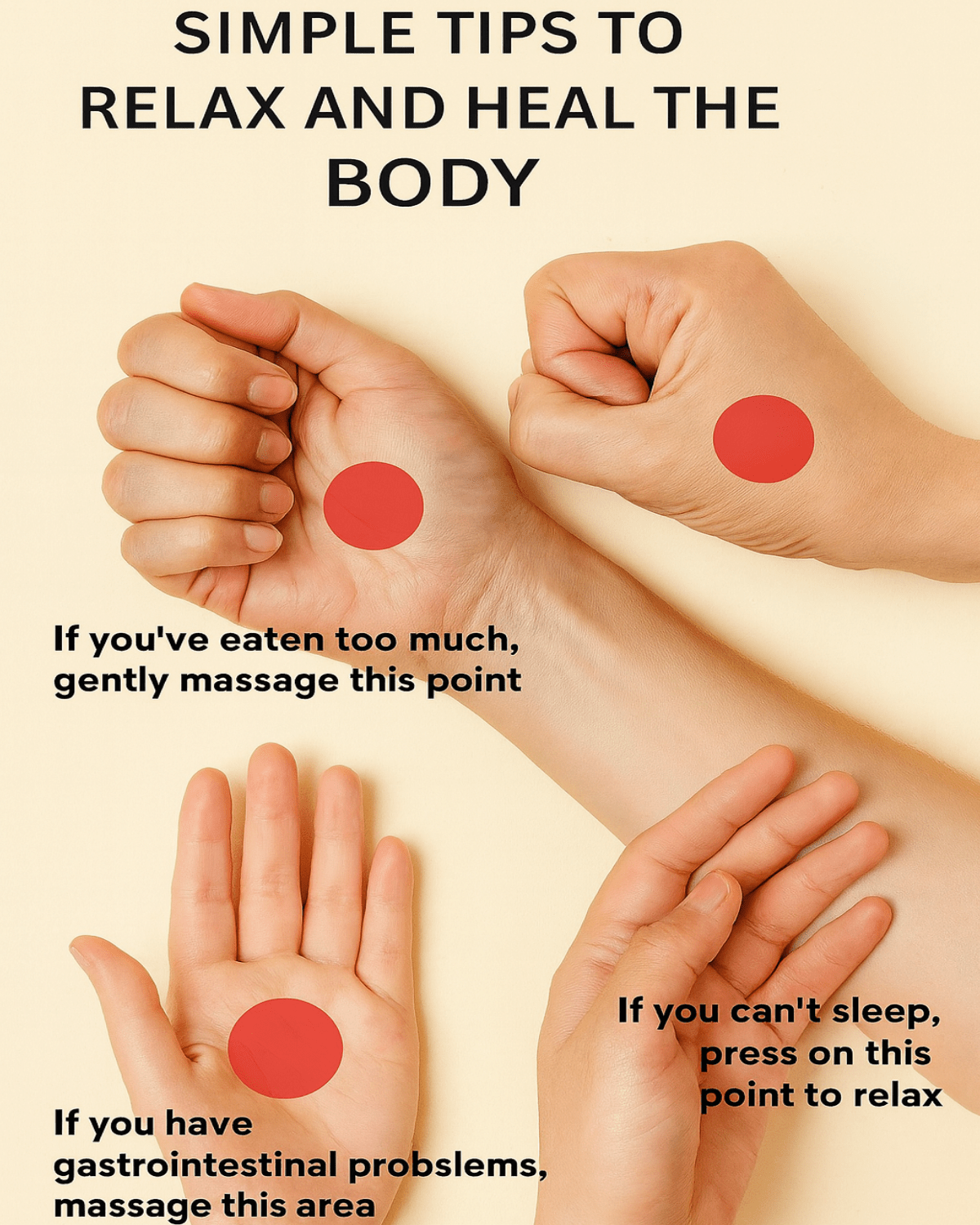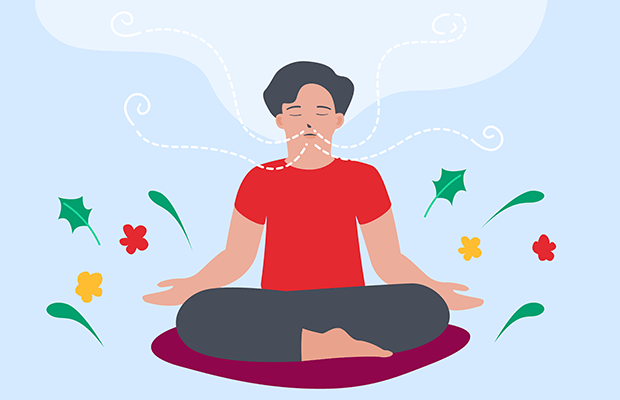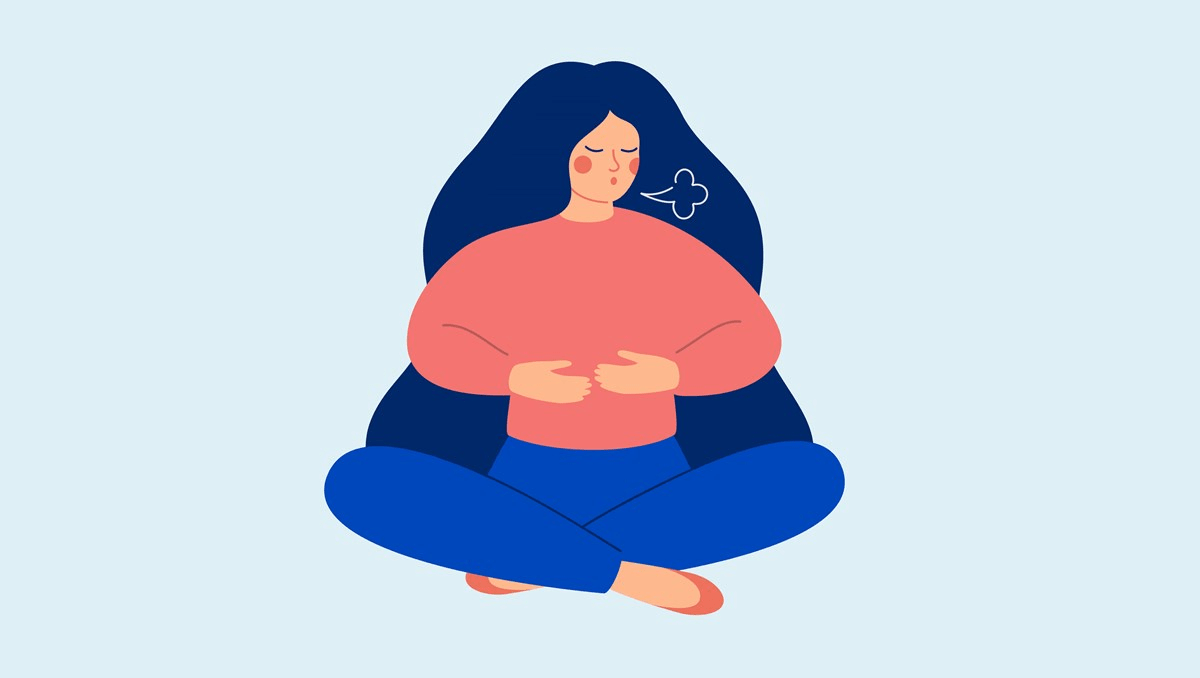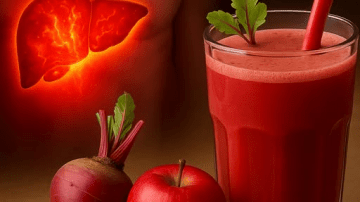Have you ever noticed how your body seems to “talk” to you? Maybe after a big dinner, there’s that tightness in your belly. Or when stress builds up, your shoulders tense as if they’re holding the world. You toss and turn at night, hoping for rest, but your mind refuses to quiet down. We’ve all been there—those moments when our body feels heavy, bloated, or restless.

Now imagine something different. Imagine being able to gently guide your body back to ease—not with pills or complicated routines—but through simple, mindful touch. A few seconds, a small movement, a quiet breath. It sounds simple because it is. But simplicity can be powerful.
Today, you’ll discover four easy techniques you can use to relax, support digestion, and calm your mind anytime, anywhere. But before we get into the “how,” let’s explore why your body needs this quiet care more than ever.
The Modern Body’s Hidden Tension
In a world that never slows down, your body rarely gets a chance to rest. We sit for hours, eat in a rush, and carry stress that quietly settles into muscles and organs. The result? Common but frustrating symptoms—bloating, indigestion, sleeplessness, or that nagging discomfort after eating.
Most people try to fix these issues with external solutions—antacids, diets, or sleeping aids—while ignoring one truth: your body already holds a built-in system to restore balance. You just need to know where to touch, how to breathe, and when to pause.
But how can pressing a small point on your body make a difference? That’s where ancient wisdom meets modern understanding.
The Gentle Science of Pressure Points
Across many cultures—from Chinese acupressure to Japanese Shiatsu—there’s a shared belief that the body carries invisible pathways of energy. When those pathways get blocked, we feel discomfort or tension. Gentle touch or massage on specific points may help restore flow and calm.
Modern science may describe it differently—stimulating nerve endings, improving circulation, releasing muscle tension—but the result often feels the same: relaxation, warmth, relief.
And the best part? You can do it yourself, safely, in just a few minutes a day.
Let’s walk through four simple ways to reconnect with your body’s natural balance.

1. When You’ve Overeaten: Support Gentle Digestion
Picture this: you’ve just finished dinner, maybe one bite too many. Your stomach feels heavy, your chest slightly full. Instead of reaching for medication, try this simple step.
Sit upright and locate the soft area about three finger-widths above your belly button. Using your fingertips, apply gentle circular pressure for about a minute. Breathe slowly—in through your nose, out through your mouth.
This motion may stimulate the digestive process and relax the stomach muscles, helping food move naturally through your system. You’ll likely feel a quiet warmth spread across your abdomen.
A small 2020 study on abdominal self-massage found that it may improve comfort and reduce the sense of fullness. Nothing extreme—just gentle support for what your body is already designed to do.
But don’t stop there—because the next tip can bring even faster relief when bloating takes over.
2. Feeling Bloated? Ease Swelling and Tension
We all know that uncomfortable moment—your waistband feels tighter, your belly expands, and your mood dips. Bloating can be caused by trapped air, sluggish digestion, or even stress itself.
To help, find the spot two fingers below your kneecap and slightly to the outside of your shin. Press gently with your thumb or knuckle in small circles for about 60 seconds on each leg. This area, known in acupressure as “ST36,” is often associated with digestion and energy regulation.
Many people report that massaging this point feels grounding—like releasing pressure from within. The effect may be subtle but real: a gradual easing, a lighter feeling, and often a calmer breath.
And while you’re feeling that shift, there’s another simple touch that can comfort your gut on stressful days.

3. For Digestive Discomfort: Calm from the Inside Out
Have you ever felt that tight, nervous flutter in your stomach before an event or stressful moment? That’s your “gut-brain connection” at work—the way emotional tension can affect digestion.
To soothe it, place your palm flat on your upper abdomen, just under your rib cage. Breathe deeply, then make slow circular motions clockwise. This simple act may stimulate the vagus nerve, which helps regulate digestion and relaxation.
Some people describe the feeling as “releasing a knot you didn’t know was there.” And that’s the beauty of it—sometimes healing doesn’t need to be dramatic; it just needs awareness.
But what if your discomfort doesn’t come from food at all? What if the problem starts when the lights go out and your mind refuses to sleep?
4. When You Can’t Fall Asleep: Find the Quiet Point
You’re lying in bed, eyes closed, but your thoughts keep spinning. Here’s a surprisingly simple trick: lightly press the center of your palm, right between the two tendons when you close your hand slightly. Hold for 30 seconds, breathe deeply, then release.
This point is associated with relaxation and emotional balance. By stimulating it, you may help calm your nervous system and signal your body that it’s time to rest. Some people even find it comforting to combine this with soft breathing—counting to four on each inhale and exhale.
The first night you try it, you might just feel your shoulders drop, your heartbeat slow, and your mind finally loosen its grip.
But wait—there’s more to this than just physical comfort.
The Mind-Body Connection You Often Overlook
Think about this: every physical sensation you experience—tightness, bloating, heaviness—often carries an emotional message. Sometimes your body holds tension your mind doesn’t yet acknowledge.
When you practice gentle touch, you’re not just helping muscles relax. You’re reminding your body that it’s safe. You’re shifting from “fight or flight” to “rest and restore.”
That’s why even two minutes of mindful pressure can feel transformative. You’re teaching your nervous system to let go.
And just when you think that’s all it does, there’s another layer you might not expect.

5. Hidden Benefits That Go Beyond Comfort
Each of these small practices has ripple effects beyond digestion or sleep. They may:
- Encourage better circulation and nutrient flow
- Support calm breathing and oxygen balance
- Reduce mental tension and fatigue
- Promote mindfulness and emotional awareness
These aren’t instant miracles—they’re small, cumulative moments of care that your body begins to recognize. Over time, you may find yourself less reactive to stress and more in tune with your needs.
Let’s see how two people experienced it differently.
Case Story 1: Maria, 47 – “From Overwhelm to Ease”
Maria often worked long hours, eating dinner late and falling asleep with a heavy stomach. After learning these techniques, she began massaging her abdomen before bed. “It’s like a gentle reminder that I can slow down,” she said. Within weeks, her evening discomfort eased, and her sleep improved.
Case Story 2: David, 54 – “A New Kind of Calm”
David suffered from bloating after every meal. Instead of avoiding food, he started practicing pressure point massage on his legs and palms. “It felt weird at first,” he admitted, “but then I realized my whole body was exhaling.”
Both found something deeper than symptom relief—they found connection.
Comparing the Benefits of Each Technique
| Situation | Area to Massage | Potential Benefit | Feeling After |
|---|---|---|---|
| Overeating | 3 fingers above the belly button | May support digestion | Warmth, relaxation |
| Bloating | 2 fingers below the kneecap | May help reduce swelling | Lightness, grounding |
| Discomfort | Upper abdomen, clockwise motion | May calm gut tension | Soothing, release |
| Sleeplessness | Center of palm | May relax nervous system | Calm, readiness for sleep |
Each technique works gently, not forcefully. Think of it as a conversation, not a command—your body responds best when treated with patience.
How to Practice Safely and Mindfully
| Step | Recommendation | Safety Tip |
|---|---|---|
| Pressure | Use gentle, comfortable force | Stop if pain occurs |
| Duration | 1–2 minutes per point | Avoid over-massaging |
| Environment | Quiet space, relaxed posture | Breathe steadily |
| Frequency | Daily or as needed | Combine with hydration and rest |
Consistency matters more than intensity. Over time, you’ll notice your body responding faster—like an old friend who finally understands your language.
A Final Thought Before You Begin
You might be thinking, Can it really be that simple? Yes—and no. The simplicity is the doorway, but awareness is the key. When you touch a pressure point, you’re not just applying physical pressure—you’re acknowledging your body’s presence, its intelligence, and its quiet request for care.
Start tonight. Choose one technique. Take a breath. Let your fingers rest where tension gathers. You may be surprised how your body listens when you finally decide to listen to it.
Because sometimes, the path to healing isn’t about adding more—it’s about coming back to what you already have: your breath, your hands, and your attention.
This article is for informational purposes only and is not a substitute for professional medical advice. Always consult your healthcare provider for personalized guidance.






